#Radicalesbians
Explore tagged Tumblr posts
Text

The Woman Identified Woman: manifesto of gay liberation group "Radicalesbians," circa 1970.
"What is a lesbian? A lesbian is the rage of all women condensed to the point of explosion. She is the woman who, often beginning at an extremely early age, acts in accordance with her inner compulsion to be a more complete and freer human being than her society--perhaps then, but certainly later--cares to allow her."
#radicalesbians#manifesto#lesbian#wlw#dykeposting#sapphic#lesbian history#feminism#lesbian ephemera#ephemera#lgbt history#1970s#dyke
50 notes
·
View notes
Text
Women in the movement have in most cases gone to great lengths to avoid discussion and confrontation with the issue of lesbianism. It puts people up-tight. They are hostile, evasive, or try to incorporate it into some "broader issue." They would rather not talk about it. If they have to, they try to dismiss it as a "lavender herring." But it is no side issue. It is absolutely essential to the success and fulfillment of the women's liberation movement that this issue be dealt with. As long as the label "dyke" can be used to frighten a woman into a less militant stand, keep her separate from her sisters, keep her from giving primacy to anything other than men and family—then to that extent she is controlled by the male culture. Until women see in each other the possibility of a primal commitment which includes sexual love, they will be denying themselves the love and value they readily accord to men, thus affirming their second-class status. As long as male acceptability is primary— both to individual women and to the movement as a whole—the term lesbian will be used effectively against women. Insofar as women want only more privileges within the system, they do not want to antagonize male power. They instead seek acceptability for women's liberation, and the most crucial aspect of the acceptability is to deny lesbianism—i.e., to deny any fundamental challenge to the basis of the female. It should also be said that some younger, more radical women have honestly begun to discuss lesbianism, but so far it has been primarily as a sexual "alternative" to men. This, however, is still giving primacy to men, both because the idea of relating more completely to women occurs as a negative reaction to men, and because the lesbian relationship is being characterized simply by sex, which is divisive and sexist. On one level, which is both personal and political, women may withdraw emotional and sexual energies from men, and work out various alternatives for those energies in their own lives. On a different political/psychological level, it must be understood that what is crucial is that women begin disengaging from male-defined response patterns. In the privacy of our own psyches, we must cut those cords to the core. For irrespective of where our love and sexual energies flow, if we are male-identified in our heads, we cannot realize our autonomy as human beings.
-Radicalesbians, ‘The Woman Identified Woman’ in Radical Feminism, Koedt et al (eds.)
#Radicalesbians#woman identified#lesbianism#radical feminist theory#womens history#women’s liberation
4 notes
·
View notes
Text
Baby sister called me up earlier bc she needed help writing a play and she was looking to add more interpersonal conflict between her characters that were lesbian activists in the 1960/70s
AKA I legit got called up and asked "give me the cliff notes on queer infighting through history" bc I am legitimately an expert on the topic so this whole thing was amazing and took 2 hours just to scratch the surface. My legacy is that I can correctly reference and cite ✨Gay Drama✨ from 50 years ago 🫳🏻
#teddy talks#personal#baby sister saga#thats gonna become a tag i feel#shes doing it on the Radicalesbians that branched off the Gay Liberation Front#taking inspo from like Martha Shelley and Rita Mae Brown and such#and she was like 'this is a 40 min play i have the plot now i need them to fight' and i said BET
0 notes
Text
Queen episode: feminist themes and lesbianism
(maybe not from the character you expect)
In Queen's episode, the themes of feminism are hard to miss. The beginning of the episode opens up with a male student in a yellow hoodie, attempting to cheat off of her exam. Then Queen goes on to make a speech about becoming X in front of a laughing male photographer and bar patrons, all while the female photographer, bartender, and future hero Loli all look on with inspiration
We learn from the media that the last time a woman was X was 20 years ago back in Year 8.
Heroes gain their abilities via public perception, meaning it has been 20 years since society believed in any woman being able to beat men for the role of X.
The cheating scandal between the X duo (and couple) Mr. Matchstick and Ms. Blazefire was even said to have spiraled into a mini gender war, increasing tensions between the sexes
Queen made her valedictorian speech during a very rough period in time for women in the tbhx universe, and the people were hungry for it, they ate it up!
this reaction to her speech led to Bowa- who was already a hero and the top female one at that- gaining an incredible amount of Trust as a result.
We learn from CEO Micky that Bowa was more than just an icon for Queen's words though, she has sacrificed an incredible amount. And I believe an aspect of what she has had to sacrifice is referenced in her lavender costume.
in the 1970s, western Lesbians adopted a Labrys (a type of axe) as a political symbol that was inspired by feminists before them.
This was later combined with the color purple and the black triangle (a symbol used by nazis to persecute "asocial" women and lesbians) into the first lesbian flag. This flag was made as a gesture of goodwill towards lesbians from the gay man Sean Campell, who noticed lesbians were being pushed out of gay circles at the time.

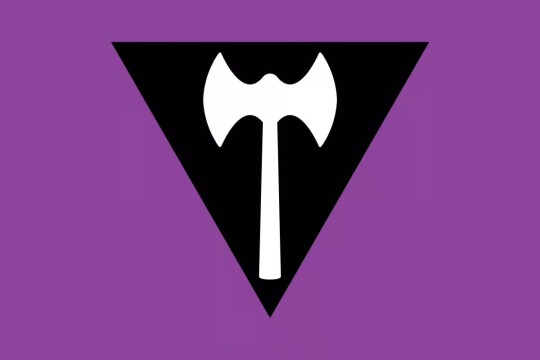
The justification of the purple color has been debated for having several meanings. The sited reason of having purple in the flag is the story of the Ancient Greek lesbian Sapphos describing the violet crowns of other women. But others insist a second meaning, that purple is a color free of gender norms. Neither pink nor blue, instead almost a combination.
Well, another shade of purple is equally important to lesbians, and that is Lavender. (The shade of purple in Bowa's outfit)


Back in the late 60s and early 70s, western Feminists were becoming harder to for mainstream media to ignore, and the dream of equality had hopes of fruition. Many feminist leaders and activists were lesbian, despite this, straight feminists feared that lesbians were hurting the movement by association. The straight feminist Betty Friedan (and president of the NOW National Organization for Women) insulted lesbians as being the "Lavender Menace" to feminism in 1969.
Rather than bow down, lesbians embraced the term, turning the insult into a point of pride. In 1970 when the "Second Congress to Unite Women" took place and suspiciously had no lesbian speakers, lesbians from the Gay Liberation Front and Radicalesbians showed up in shirts proudly proclaiming "Lavender Menace" on each of their chests. They demanded that lesbians not be excluded from the very feminist movement they were pivotal in helping build.
this moment in history solidified the term "lavender menace" as a phrase for Lesbian Feminists.
I dont think it's pure coincidence that Bowa's uniform has her in all lavender and sporting a labrys. The very first thing that came to my mind seeing her and her labrys was that photo of 1988 Lesbian Strength!
Early American feminists and lesbian feminists are famous to feminists worldwide, I think Bowa's uniform and her sacrifice are related to her lesbianism. What she has had to hide and forgo, to instead become "the perfect blend of beauty and strength" for an audience to project onto.
While Queen is unashamedly herself, proclaiming it was her belief in herself that gave her power, Bowa is instead hiding her true self and unable to detach herself from both the words and expectations of others
122 notes
·
View notes
Text
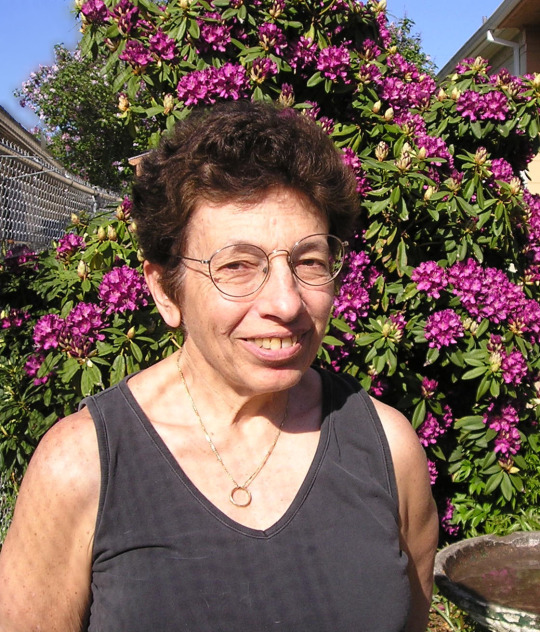
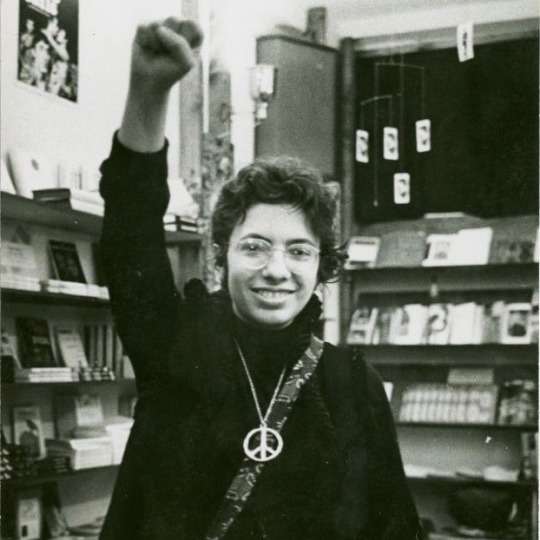
Martha Shelly is a Jewish activist lesbian and feminist.
She was involved in many forms of activism including the Vietnam anti war protests and was an ally to the Black Panthers. She joined the Daughters of Bilitis, a lesbian civil rights group, in 1967, and later went on to become president of the New York chapter. While working as a secretary in the office of fundraising for Barnard College, she joined the Student Homophile League.
After witnessing the Stonewall riots and seeing the public reaction Martha was inspired to organize a protest. With the DOB and the Mattachine Society they organized the first gay protest march in America, shortly after that, they formed the Gay Liberation Front. She became the face of the movement, going on tv programs and speaking at public events.
As a young adult her therapist put her through a conversation therapy of sorts, she insisted she try to be bisexual as to not “give up on half the world in her dating pool”. She tried for a while, getting with other gay men put in this program and went on to date bisexual activist Stephen Donaldson. But after her working with the GLF and getting more involved with her community she accepted herself as a lesbian.
At the time lesbians were considered a threat to the feminist movement. The president of The National Organization for Women Betty Friedan called lesbians in the movement a “lavender menace” and the organization distanced themselves from lesbian causes and even omitted the sponsorship of the DOB. Women from DOB and the GLF, including Martha, joined together to create the group ‘Lavender Menace’ in response. Together, dawning shirts and signs they protested at a NOW event for lesbian causes to be included.
My job was to jump up on the stage and grab the mic. I explained that we were here because lesbians had been excluded, and we wanted to talk about our issues. Then I put it to the audience. "Let's take a vote how many want to continue with the panel discussion? How many want to hear what we have to say?" The women voted overwhelmingly to hear from us. Then other Menaces marched down the aisle and stepped up onto the stage, while a few remained in the audience. A freewheeling discussion ensued. At their next annual conference NOW revised their platform to include lesbian rights.
The group was soon after renamed the Radicalesbians.
Despite members of the group partaking in it, Martha did not consider herself a lesbian separatist. She liked the idea of lesbian only spaces but thought that splitting the gay movement into smaller groups would weaken the movement as a whole.
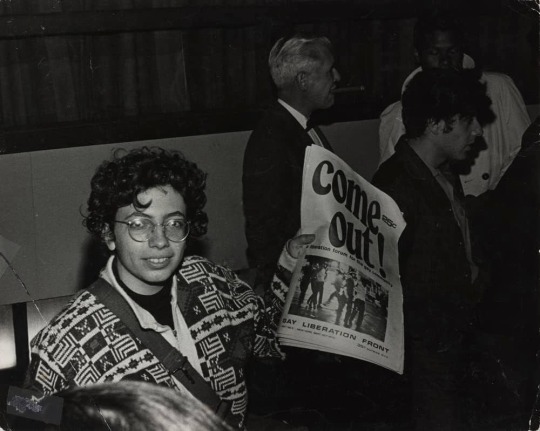
Sources:
We Set the Night on Fire: Igniting the Gay Revolution by Martha Shelley (2023)
Martha Shelley - Wikipedia
#martha shelley#lgbt history#lesbian history#queer history#feminist history#lesbianism#lgbt education#activists#people#feminism#lgbtq community#lesbians in action
275 notes
·
View notes
Text
Alright, in light of all the drama™ going around on radblr right now I think we should all go and reread "The Woman-Identified Woman" by the Radicalesbians (1970). I think this quote articulates the issue really well...
As long as woman's liberation tries to free women without facing the basic heterosexual structure that binds us in one-to-one relationship with our oppressors, tremendous energies will continue to flow into trying to straighten up each particular relationship with a man, into finding how to get better sex, how to turn his head around-into trying to make the "new man" out of him, in the delusion that this will allow us to be the "new woman. " This obviously splits our energies and commitments, leaving us unable to be committed to the construction of the new patterns which will liberate us.
#rad fem#radical feminism#terfsafe#rad fem safe#terfblr#radblr#radical feminists please interact#radical feminst#radical feminists do touch#radical feminist safe
87 notes
·
View notes
Text
i was supposed to take things slow om this front, but i don't think i actually have the time.
we're antipsychiatry, which is not to say that we don't think neurodivergence/insanity exists nor that we think that symptoms can be overcome via willpower or crystals or what have you, but rather that we think that psychiatry and psychiatrists should not have the kind of ultimate authority that they do.
psychiatry was founded on using white cishet men as models of human normalcy, and is a tool for social and political control. ableism is not individual bias, but a system of power, prejudice, and control that uses psychiatry as a means by which it operates.
foucault writes extensively about this, and more can be read about it in "the protest psychosis" by johnathan metzl, which explains how psychiatry has been used to stifle Black activists and activism.
that latter in particular has a long history, dating back to the hypothesis of "drapetomania", which was an idea in the 1800s that enslaved Black people seeking freedom were mentally ill.
such bigotry followed psychiatry into the twentieth and twenty first centuries, with gayness and transness listed as mental illnesses in the dsm and "oppositional defiance disorder" being leveraged against Black children in school.
(as a brief aside, homosexuality was only removed from the dsm due to direct protests by gay people at psychiatric classes and conferences, often in "zaps", which were modelled after protests of the vietnam war. the account of one lesbian participating in such a protest can be read in "smash the church, smash the state", a collection of biographic essays by various lgbt activists edited by tommi avecolli mecca. [skip the radicalesbians parts, they were terfs].)
now, with the above in mind we know it to be crucial that systems/plural people find a way to break our understanding of ourselves from this system of control and understanding.
(my girlfriend distracted me and this post is getting very long, so i'll end here.)
- sapphire
3 notes
·
View notes
Text
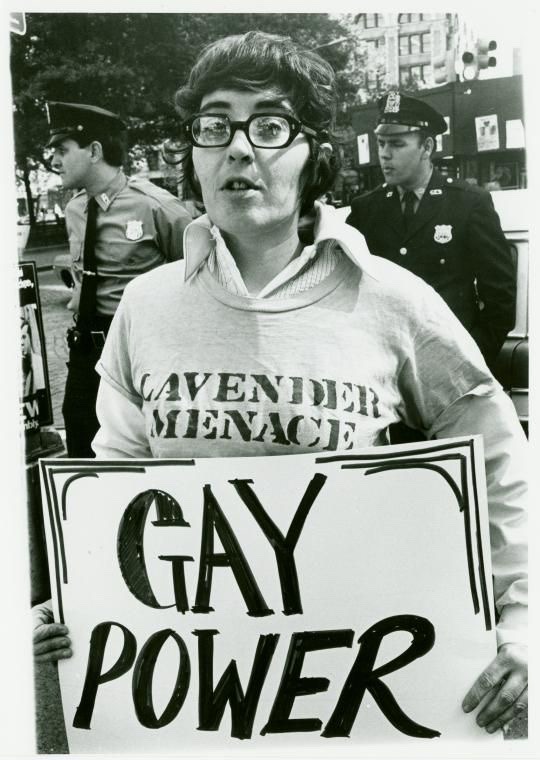
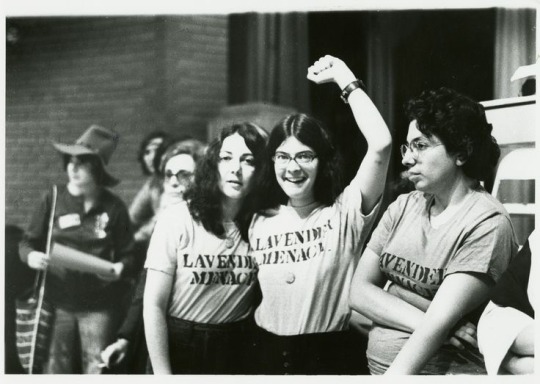
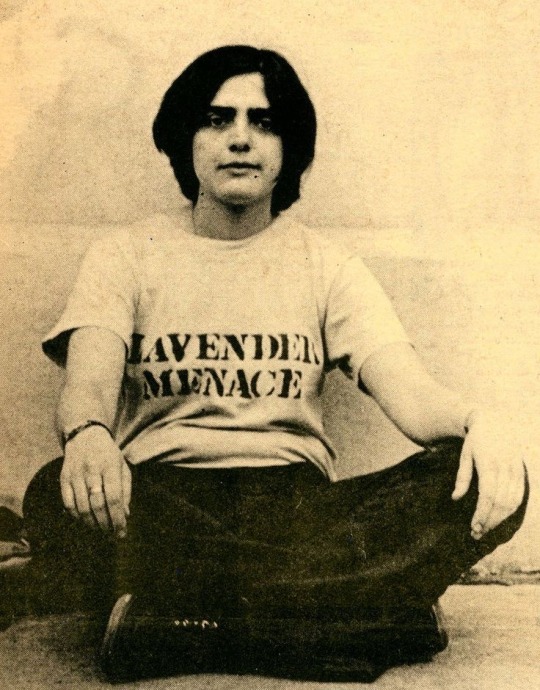
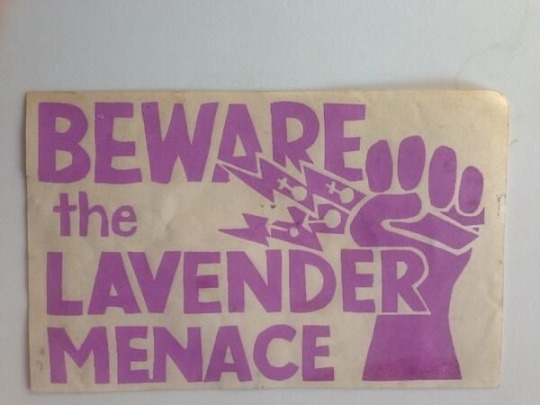
“Lavender Menace” was an action led by Radicalesbians, with women from the Gay Liberation Front and several feminist organizations, at the National Organization for Women’s (NOW) Second Congress to Unite Women in May 1970 to protest the rejection of lesbians in the second-wave women’s liberation movement.
This action largely led to NOW’s resolution to support lesbians in 1971 and increased visibility for and awareness of lesbian issues nationwide.
(source: https://www.nyclgbtsites.org/site/lavender-menace-action-at-second-congress-to-unite-women/ )
#queer liberation#queer community#queer history#queer#queer pride#lesbianism#butch lesbian#femme lesbian#lesbian#lesbian history#lesbian pride#lavender menace#gay pride#lgbt pride#pride#wlw pride#sapphic#sapphic history#lgbtqia#lgbtq community#lgbtq#lgbt#lgbt history#lgbtpride#lgbtq history#lgbtq+#lgbtqia+
7 notes
·
View notes
Note
i want to make sure you know that radfem is based in transphobia against trans women and trans people in general in case you didn’t know that. if you do know that please block me as i’m a trans man and i don’t want transphobes following me :)
In a few words, it is possible to refute this misinformation spread in the Radfem environment.
With small topics we can start with:
What is radfem or what it means? Radical feminism is a perspective within feminism that proposes a radical reordering of society in which male supremacy is eliminated in all social and economic contexts.
This current emerged between the 60s and 70s and argues that the root — where the word radical comes from — of all oppression is patriarchy.
Radfem ITSELF is not transphobic and DOES NOT HAVE transphobic roots, but the women within it have distorted its meaning so much that we ended up being mistaken for femists.
As proof we have the radical lesbofeminist movement itself, Lavender Menace.
In 1970, Lavender Menace, later Radicalesbians, organized the Lavender Menace zap of the Second Congress to Unite Women. Martha Shelley played an instrumental role in the zap itself, and some have claimed she assisted in the writing of the Radicalesbians manifesto, "The Woman-Identified Woman", which introduced "women-identified" and "male-identified" terminology to the lesbian feminist discourse community.
Feminism is a movement that fights for social equality and rights for women and seeks to combat the social model based on patriarchy and abuse and violence against women. At no point do movements revolve around social genders or biological sexes, this is not the objective of feminism (in general)!
Any ideology that seeks to superiorize female biological SEX is no longer feminism, we want equality and not superiority.
Radfem is not against trans people, the femists who hide here are.
- ♨️
#radical feminism#radical feminist community#para safe#paraphile community#pro radqueer#pro transx#transid#radqueers please interact#radqueer safe#rq 🍓🌈
4 notes
·
View notes
Text
Australian Queer Archives YouTube channel launches with Moments of Time
New Post has been published on https://qnews.com.au/australian-queer-archives-youtube-channel-launches-with-moments-of-time/
Australian Queer Archives YouTube channel launches with Moments of Time
Watch Moments in Time, celebrating people, places and events that made Australian queer history on the Australian Queer Archives new YouTube channel.
Originally broadcast on QTV on Channel 31 between 2019 and 2020, Moments in Time relives the events that made Australian queer history.
The series was produced by Bill Calder, publisher of queer media titles such as Brother Sister, and Graham Willett, historian and former AQuA president.
The collection of videos were launched at the start of the month on the newly created Australian Queer Archives YouTube channel.
“We produced QTV as a half-hour news variety show and decided to add a history segment in,” Bill told us,
“The Moments in Time segments were only three minutes long.”
“We planned to use them in other ways as conversation starters or for education.
“A lot can be said in three minutes, still, it was a challenge we wanted to take on.
“We also had to go with the times of what media is now, it’s quite shorter and sharper and snappier.”
Images: Australian Queer Archives
Sharing our stories.
The history series introduces LGBTQ+ people from the past, such as bushranger Captain Moonlite, all-female run garage proprietor Alice Anderson, and Florence Cox, who experienced intersex discrimination.
It revisits events that changed our history, like the Black Rock beat raids in the 1970s, which highlighted police harassment, Melbourne’s first Gay Pride Week, and the Sorrento Radicalesbians conference that unleashed a new voice for change.
Iconic venues such as Pokeys in St Kilda, Val’s Coffee Shop in the Melbourne CBD, and The Hub, which was Melbourne’s first pride centre are highlighted.
Writing about these stories in texts is something historian Graham Willett is used to, but this format was still a learning curve.
“This is a bit new for me and will hopefully be a way to reach a different audience,” Graham said.
“We do the Monty Puncheon, the world’s oldest lesbian in three minutes, and in the last twelve months her entire biography has come out.”
“It was a creative way for us to present history.
“The archives have a huge collection, in all sorts of different formats, books and badges and t t-shirts and so on.
“We are proud to be able to add digital material for people to watch and launch on their YouTube Channel while they can continue to make other digital work available.”
Image: QTV
Giving our history a wider view.
Each of the three seasons of Moments in Time has 13 short episodes.
Moments in Time Season One episodes focus on:
Gay Bushranger Captain Moonlight
HIV Activist Bill Hathaway
The Black Rock Beat Raids
The Woolshed Bar Kiss-In
Myer window dresser Freddie Assmussen
Mac Du Barrie, a larger-than-life figure in Melbourne’s camp scene
An all-female garage run by Alica Anderson
Val Eastwood
Nineteenth century sportswoman Harriet Elphinstone Dick
Michael Glynn – Founder of the Sydney Star newspaper
Edward du Lacy Evans
Early sex educator Robert Storer
Sorrento Radical Lesbians Conference
Moments in Time Season Two episodes focus on:
Australia’s first activist group, the Campaign Against Moral Persecution
The Candlelight Vigil
Florence Cox, who experienced intersex discrimination
One of our earliest venue promoters, Jan Hillier
Miss Candee and the transforming power of the Pink Dollar
The successful same sex marriage campaign in Australia
The Tasty Bar raid in Melbourne
Graham Carbery, AQuA founder
Monte Punshon, who, when she died aged 106, was dubbed the world’s oldest lesbian
OutRage, one of the great queer magazines from the past.
Superstar Gladys Moncrieff: 1920s & 1930s musical opera singer and her partner, Elsie Wilson.
Mac Ronan founded the ALSO Foundation, which organised great dance parties such as Red Raw.
Charlie and Lance, who fell in love in 1919, but the law intervened and locked Lance up.
Moments in Time Season Three episodes focus on:
Melbourne’s first Gay Pride Week
A long-established kamp-friendly church
‘Free entertainment in public places’
A social club with ambitions
The Laird
Annabels Hotel
Rainbow Sash Movement
Trish’s Coffee Lounge
Flats and boarding houses in St Kilda early 20th century provided a sanctuary
Mandate Bar in St Kilda
The Hub – Victoria’s first pride centre
Fairfield AIDS Memorial Garden
Pokeys
Both Bill and Graham are proud that something gets to continue having a historic legacy and a greater voice thanks to the Australian Queer Archives.
“I’m very happy that these stories will get a wider view,” Bill said,
“That’s why we tell stories, to have people listen to them and learn something from them.”
Each Moments in Time video is roughly three minutes, so you can sit back and watch them all or take them in at your leisure.
You can check out all the episodes here.
Source: Australian Queer Archives
For the latest LGBTIQA+ Sister Girl and Brother Boy news, entertainment, community stories in Australia, visit qnews.com.au. Find us on Facebook, Twitter, Instagram and YouTube.
0 notes
Text
The issue of lesbianism really exploded on May 1, 1970, opening night of the second Congress to Unite Women, when forty lesbians pre-empted the scheduled proceedings to raise the issue of lesbianism. (The divisiveness over class and lesbianism prompted some women to dub this the "Congress to Divide Women.") The action was planned by a group that included Brown, Funk, Hoffman, Hart, and Bedoz. The following account of the "Lavender Menace" action appeared in the women's underground paper Rat:
“On May 1st, at 7:15 p.m. about 300 women were quietly sitting in the auditorium of intermediate school 70 waiting for the Congress to Unite Women to come to order. The lights went out, people heard running, laughter, a rebel yell here and there, and when those lights were turned back on, those same 300 women found themselves in the hands of the LAVENDER MENACE. . . . Seventeen of the Radical lesbians wore lavender t-shirts with LAVENDER MENACE stenciled across the front. These women were the first wave of the action and the ones who took over the auditorium.”
The other demonstrators were dispersed throughout the audience and were supposed to declare their support for the action and join the women on stage. Once on stage, they would reveal both their Lavender Menace t-shirts and their lesbianism. However, as Woodul explains, the demonstrators needn't have acted as "pigeons" in the audience for "as soon as the floor was taken, women by the droves began to come up on stage." For two hours the protestors held the floor as they talked about what it was like to be a lesbian in a heterosexist culture. The final assembly of the Congress adopted the set of resolutions advanced by "The Lavender Menace: Gay Liberation Front Women and Radical Lesbians." The resolutions read:
“1. Women's Liberation is a lesbian plot. 2. Whenever the label lesbian is used against the movement collectively or against women individually, it is to be affirmed, not denied. 3. In all discussions of birth control, homosexuality must be included as a legitimate method of contraception. 4. All sex education curricula must include lesbianism as a valid, legitimate form of sexual expression and love.”
One of the most important things to come out of the Congress action was the Radicalesbian position paper, "The Woman-Identified Woman," copies of which were distributed to women in the audience. Like the action, the paper was designed to assuage heterosexual feminists' fears about lesbianism. In fact, Jennifer Woodul contends that the "Menaces" decided to use the term "woman-identified" because they hoped it would prove less threatening to heterosexual women:
“I was there when the ideas for ‘Woman-Identified Woman’ were beginning to take shape. We were trying to figure out how to tell women about lesbianism without using the word, lesbian, because we found that at these conferences we kept freaking people out all the time. And I believe it was Cynthia [Funk] who came up with this term, ‘woman-identified.’ At least, that was the first time I had ever heard it. So what we were trying to do was make women realize that lesbians were not different from other women in any sort of strange way.”
To legitimize lesbianism, Radicalesbians had to persuade feminists that lesbianism was not simply a bedroom issue and that lesbians were not male-identified "bogeywomen" out to sexually exploit other women. They accomplished this by redefining lesbianism as a primarily political choice and by locating the discourse within the already established feminist framework of separatism. They criticized as “divisive and sexist” the tendency to characterize lesbianism "simply by sex." Moreover, they suggested that far from being male-identified, lesbians, by virtue of their distance from contaminating maleness, were actually more likely to be woman-identified than heterosexual women who were "dependent upon male culture for their [self]-definition:"
“Only women can give to each other a new sense of self. That identity we have to develop with reference to ourselves, and not in relation to men. . . . Our energies must flow toward our sisters, not backward toward our oppressors. As long as women's liberation tries to free women without facing the basic heterosexual structure that binds us in one-to-one relationship with our oppressors, tremendous energies will continue to flow into trying to straighten up each particular relationship with a man. . . . This obviously splits our energies and commitments, leaving us unable to be committed to the construction of the new patterns which will liberate us.”
Although the paper's tone was not antagonistic—for instance, they avoided defining heterosexual women as collaborators—the assumption was that feminism required lesbianism:
“It is the primacy of women, of women creating a new consciousness of and with each other, which is at the heart of women's liberation, and the basis for the cultural revolution.”
"The Woman-Identified Woman" was not the earliest expression of lesbian-feminism. Both Rita Mae Brown and Martha Shelley had angrily denounced movement homophobia in the pages of Rat and Come Out, respectively. But what set "The Woman-Identified Woman" apart from these earlier pieces, what made it so significant, was that it redefined lesbianism as the quintessential act of political solidarity with other women. By defining lesbianism as a political choice rather than a sexual alternative, Radicalesbians disarmed heterosexual feminists. Of course, the knotty problem of sexuality remained. Even Radicalesbians had to admit that lesbianism involved sex:
“Until women see in each other the possibility of a primal commitment which includes sexual love, they will be denying themselves the love and value they readily accord to men, thus affirming their second-class status.”
The introduction of sex troubled many heterosexual feminists who had found in the women's movement a welcome respite from sexuality. Ellen DuBois was just one of many heterosexual feminists who initially resented the intrusion of sexuality into the movement:
“I felt finally I had found a movement where I didn't have to worry about whether or not I was attractive or whether or not men liked me. . . . And just as I was beginning to feel here at last I could forget all of that, sex once again reared its ugly head.”
-Alice Echols, Daring to Be Bad: Radical Feminism in America: 1967-75
#Alice Echols#radical feminist history#lesbianism#heterosexuality#womens liberation#womens history#human sexuality#political lesbianism
13 notes
·
View notes
Text
girlhood/identity (week three)
you existed first inside your grandmother
i think about it all the time - charli xcx —> https://genius.com/Charli-xcx-i-think-about-it-all-the-time-lyrics
motherhood viewed as a signifier of supreme womanhood
woman reduced to vessel
something sean said stuck out to me— women have inherent worth in society whereas men have to earn it
is that because they’re a vessel for children?
or is that just because men/sean not viewing them on the same level
it’s easy to call a man a loser if he’s not attractive & doesn’t have a good job, but sean felt differently calling the same person a loser if they were a woman
maybe cause women are already at a disadvantage
so does this “loser” denotation only apply to white men?
discussion with gabby
it’s crazy that the “male loneliness epidemic” is being perpetuated by men themselves
if u don’t have a safe space, make one!
no self reflection about contribution and effects of patriarchal system
it seems like men are expecting people to accomodate for them
discussion with shannon
line between girlhood and motherhood is indistinguishable
mothers were always girls first
motherhood is pushed on girls immediately
baby dolls
younger siblings
women have to care about men’s mental health because it can harm them (whereas the opposite is not true on a large scale)
lesbian continuum → https://literariness.org/2017/10/25/lesbian-continuum-a-brief-note/
“Ultimately the idea of the lesbian continuum is about re-establishing the importance of all women’s women-identified experiences in life, regardless of their stated sexual orientation. In common with Radicalesbians, Rich prioritises all communication with women, implying that men are incapable of being nurturant or supportive or able to sustain close friendships with men.”
lesbianism = decenter men
dani’s story about her cousin
cousin has not expressed that she wants to have kids
pressure to have grandkids even
reflection
don't really want to think about being mad about/empowering men's issues for my topic
next week want to look into more mother/daughter relations
also should look into different cultures and how a female-led community changes things
explore the relationship between me and my sister
why do we feel so connected when other siblings don't?
also think about how gender non-conforming individuals fit into this conversation
0 notes
Text


the woman-identified woman, radicalesbians
#feminism#radical feminism#reclaim radical feminism#transfeminism#lesbian#lesbian feminism#much larger dissection of this manifesto incoming. just been thinking about it a lot recently#means a lot to me#going to print this and put it on my wall. along with the principles of environmental justice#feminist readings
0 notes
Text
The Woman-Identified Woman
by the Radicalesbians (1970)
What is a lesbian? A lesbian is the rage of all women condensed to the point of explosion. She is the woman who, often beginning at an extremely early age, acts in accordance with her inner compulsion to be a more complete and freer human being than her society - perhaps then, but certainly later - cares to allow her. These needs and actions, over a period of years, bring her into painful conflict with people, situations, the accepted ways of thinking, feeling and behaving, until she is in a state of continual war with everything around her, and usually with her self. She may not be fully conscious of the political implications of what for her began as personal necessity, but on some level she has not been able to accept the limitations and oppression laid on her by the most basic role of her society--the female role. The turmoil she experiences tends to induce guilt proportional to the degree to which she feels she is not meeting social expectations, and/or eventually drives her to question and analyze what the rest of her society more or less accepts. She is forced to evolve her own life pattern, often living much of her life alone, learning usually much earlier than her "straight" (heterosexual) sisters about the essential aloneness of life (which the myth of marriage obscures) and about the reality of illusions. To the extent that she cannot expel the heavy socialization that goes with being female, she can never truly find peace with herself. For she is caught somewhere between accepting society's view of her - in which case she cannot accept herself - and coming to understand what this sexist society has done to her and why it is functional and necessary for it to do so. Those of us who work that through find ourselves on the other side of a tortuous journey through a night that may have been decades long. The perspective gained from that journey, the liberation of self, the inner peace, the real love of self and of all women, is something to be shared with all women - because we are all women.
It should first be understood that lesbianism, like male homosexuality, is a category of behavior possible only in a sexist society characterized by rigid sex roles and dominated by male supremacy. Those sex roles dehumanize women by defining us as a supportive/serving caste in relation to the master caste of men, and emotionally cripple men by demanding that they be alienated from their own bodies and emotions in order to perform their economic/political/military functions effectively. Homosexuality is a by-product of a particular way of setting up roles ( or approved patterns of behavior) on the basis of sex; as such it is an inauthentic ( not consonant with "reality") category. In a society in which men do not oppress women, and sexual expression is allowed to follow feelings, the categories of homosexuality and heterosexuality would disappear.
But lesbianism is also different from male homosexuality, and serves a different function in the society. "Dyke" is a different kind of put-down from "faggot", although both imply you are not playing your socially assigned sex role. . . are not therefore a "real woman" or a "real man. " The grudging admiration felt for the tomboy, and the queasiness felt around a sissy boy point to the same thing: the contempt in which women-or those who play a female role-are held. And the investment in keeping women in that contemptuous role is very great. Lesbian is a word, the label, the condition that holds women in line. When a woman hears this word tossed her way, she knows she is stepping out of line. She knows that she has crossed the terrible boundary of her sex role. She recoils, she protests, she reshapes her actions to gain approval. Lesbian is a label invented by the Man to throw at any woman who dares to be his equal, who dares to challenge his prerogatives (including that of all women as part of the exchange medium among men), who dares to assert the primacy of her own needs. To have the label applied to people active in women's liberation is just the most recent instance of a long history; older women will recall that not so long ago, any woman who was successful, independent, not orienting her whole life about a man, would hear this word. For in this sexist society, for a woman to be independent means she can't be a woman - she must be a dyke. That in itself should tell us where women are at. It says as clearly as can be said: women and person are contradictory terms. For a lesbian is not considered a "real woman. " And yet, in popular thinking, there is really only one essential difference between a lesbian and other women: that of sexual orientation - which is to say, when you strip off all the packaging, you must finally realize that the essence of being a "woman" is to get fucked by men.
"Lesbian" is one of the sexual categories by which men have divided up humanity. While all women are dehumanized as sex objects, as the objects of men they are given certain compensations: identification with his power, his ego, his status, his protection (from other males), feeling like a "real woman, " finding social acceptance by adhering to her role, etc. Should a woman confront herself by confronting another woman, there are fewer rationalizations, fewer buffers by which to avoid the stark horror of her dehumanized condition. Herein we find the overriding fear of many women toward being used as a sexual object by a woman, which not only will bring her no male-connected compensations, but also will reveal the void which is woman's real situation. This dehumanization is expressed when a straight woman learns that a sister is a lesbian; she begins to relate to her lesbian sister as her potential sex object, laying a surrogate male role on the lesbian. This reveals her heterosexual conditioning to make herself into an object when sex is potentially involved in a relationship, and it denies the lesbian her full humanity. For women, especially those in the movement, to perceive their lesbian sisters through this male grid of role definitions is to accept this male cultural conditioning and to oppress their sisters much as they themselves have been oppressed by men. Are we going to continue the male classification system of defining all females in sexual relation to some other category of people? Affixing the label lesbian not only to a woman who aspires to be a person, but also to any situation of real love, real solidarity, real primacy among women, is a primary form of divisiveness among women: it is the condition which keeps women within the confines of the feminine role, and it is the debunking/scare term that keeps women from forming any primary attachments, groups, or associations among ourselves.
Women in the movement have in most cases gone to great lengths to avoid discussion and confrontation with the issue of lesbianism. It puts people up-tight. They are hostile, evasive, or try to incorporate it into some ''broader issue. " They would rather not talk about it. If they have to, they try to dismiss it as a 'lavender herring. " But it is no side issue. It is absolutely essential to the success and fulfillment of the women's liberation movement that this issue be dealt with. As long as the label "dyke" can be used to frighten women into a less militant stand, keep her separate from her sisters, keep her from giving primacy to anything other than men and family-then to that extent she is controlled by the male culture. Until women see in each other the possibility of a primal commitment which includes sexual love, they will be denying themselves the love and value they readily accord to men, thus affirming their second-class status. As long as male acceptability is primary-both to individual women and to the movement as a whole-the term lesbian will be used effectively against women. Insofar as women want only more privileges within the system, they do not want to antagonize male power. They instead seek acceptability for women's liberation, and the most crucial aspect of the acceptability is to deny lesbianism - i. e., to deny any fundamental challenge to the basis of the female.
It should also be said that some younger, more radical women have honestly begun to discuss lesbianism, but so far it has been primarily as a sexual "alternative" to men. This, however, is still giving primacy to men, both because the idea of relating more completely to women occurs as a negative reaction to men, and because the lesbian relationship is being characterized simply by sex, which is divisive and sexist. On one level, which is both personal and political, women may withdraw emotional and sexual energies from men, and work out various alternatives for those energies in their own lives. On a different political/psychological level, it must be understood that what is crucial is that women begin disengaging from male-defined response patterns. In the privacy of our own psyches, we must cut those cords to the core. For irrespective of where our love and sexual energies flow, if we are male-identified in our heads, we cannot realize our autonomy as human beings.
But why is it that women have related to and through men? By virtue of having been brought up in a male society, we have internalized the male culture's definition of ourselves. That definition consigns us to sexual and family functions, and excludes us from defining and shaping the terms of our lives. In exchange for our psychic servicing and for performing society's non-profit-making functions, the man confers on us just one thing: the slave status which makes us legitimate in the eyes of the society in which we live. This is called "femininity" or "being a real woman" in our cultural lingo. We are authentic, legitimate, real to the extent that we are the property of some man whose name we bear. To be a woman who belongs to no man is to be invisible, pathetic, inauthentic, unreal. He confirms his image of us - of what we have to be in order to be acceptable by him - but not our real selves; he confirms our womanhood-as he defines it, in relation to him- but cannot confirm our personhood, our own selves as absolutes. As long as we are dependent on the male culture for this definition. For this approval, we cannot be free.
The consequence of internalizing this role is an enormous reservoir of self-hate. This is not to say the self-hate is recognized or accepted as such; indeed most women would deny it. It may be experienced as discomfort with her role, as feeling empty, as numbness, as restlessness, as a paralyzing anxiety at the center. Alternatively, it may be expressed in shrill defensiveness of the glory and destiny of her role. But it does exist, often beneath the edge of her consciousness, poisoning her existence, keeping her alienated from herself, her own needs, and rendering her a stranger to other women. They try to escape by identifying with the oppressor, living through him, gaining status and identity from his ego, his power, his accomplishments. And by not identifying with other "empty vessels" like themselves. Women resist relating on all levels to other women who will reflect their own oppression, their own secondary status, their own self-hate. For to confront another woman is finally to confront one's self-the self we have gone to such lengths to avoid. And in that mirror we know we cannot really respect and love that which we have been made to be.
As the source of self-hate and the lack of real self are rooted in our male-given identity, we must create a new sense of self. As long as we cling to the idea of "being a woman, '' we will sense some conflict with that incipient self, that sense of I, that sense of a whole person. It is very difficult to realize and accept that being "feminine" and being a whole person are irreconcilable. Only women can give to each other a new sense of self. That identity we have to develop with reference to ourselves, and not in relation to men. This consciousness is the revolutionary force from which all else will follow, for ours is an organic revolution. For this we must be available and supportive to one another, five our commitment and our love, give the emotional support necessary to sustain this movement. Our energies must flow toward our sisters, not backward toward our oppressors. As long as woman's liberation tries to free women without facing the basic heterosexual structure that binds us in one-to-one relationship with our oppressors, tremendous energies will continue to flow into trying to straighten up each particular relationship with a man, into finding how to get better sex, how to turn his head around-into trying to make the "new man" out of him, in the delusion that this will allow us to be the "new woman. " This obviously splits our energies and commitments, leaving us unable to be committed to the construction of the new patterns which will liberate us.
It is the primacy of women relating to women, of women creating a new consciousness of and with each other, which is at the heart of women's liberation, and the basis for the cultural revolution. Together we must find, reinforce, and validate our authentic selves. As we do this, we confirm in each other that struggling, incipient sense of pride and strength, the divisive barriers begin to melt, we feel this growing solidarity with our sisters. We see ourselves as prime, find our centers inside of ourselves. We find receding the sense of alienation, of being cut off, of being behind a locked window, of being unable to get out what we know is inside. We feel a real-ness, feel at last we are coinciding with ourselves. With that real self, with that consciousness, we begin a revolution to end the imposition of all coercive identifications, and to achieve maximum autonomy in human expression.
#since nobody would read the entire thing on my last post#this is my response to “the drama”#rad fem safe#radical feminst#radical feminism#radical feminist safe#radical feminists do touch#radical feminists please interact#radblr#terfsafe#terfblr#rad fem
13 notes
·
View notes
Note
lesbian-arc/hives is a crypto (also radicalesbians is often a dogwhistle despite important history of the group so the first photo is a tip-off)
proof - one of their top tags is 'gynoce/ntrism'
hmm thanks for this info. can u dm more info on this archive group? if u feel comfy doing it…
0 notes
Text
including:
Notes from the First Year by the New York Radical Women
Notes from the Second Year
Notes from the Third Year
Woman-Identified Woman by the Radicalesbians
The Bitch Manifesto by Jo Freeman
0 notes